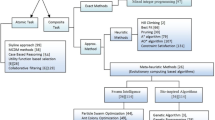Abstract
This paper present an architecture based on evolutionary genetic algorithms for generating online adaptive services. Online adaptive systems provide flexible services to a mass of clients/users for maximising some system goals, they dynamically adapt the form and the content of the issued services while the population of clients evolve over time. The idea of online genetic algorithms (online GAs) is to use the online clients response behaviour as a fitness function in order to produce the next generation of services. The principle implemented in online GAs, “the application environment is the fitness”, allow to model highly evolutionary domains where both services providers and clients change and evolve over time. The flexibility and the adaptive behaviour of this approach seems to be very relevant and promising for applications characterised by highly dynamical features such as in the web domain (online newspapers, e-markets, websites and advertising engines). Nevertheless the proposed technique has a more general aim for application environments characterised by a massive number of anonymous clients/users which require personalised services, such as in the case of many new IT applications.
Preview
Unable to display preview. Download preview PDF.
Similar content being viewed by others
References
Kobsa, A., Wahlster, W. (eds.): User Models in Dialog Systems. Springer, London (1989)
Zadeh, L.A.: Fuzzy Sets Information and Control 8(3), 338–353 (1965)
Monfared, M.A.S., Steiner, S.J.: Fuzzy adaptive scheduling and control systems. Fuzzy Sets and Systems 115(2), 231–246 (2000)
Binder, J., Koller, D., Russell, S., Kanazawa, K.: Adaptive probabilistic networks with hidden variables. Machine Learning (1997)
Holland, J.: Adaptation in Natural and Artificial Systems. University of Michigan Press, Michigan (1975)
Whitley, D.: An overview of evolutionary algorithms. Information and Software Technology (2001)
Anderson, J.A.: An Introduction to Neural Networks. MIT Press, Boston (1995)
Hagen, M.T., Demuth, H.B., Beale, M.: Neural Network Design. PWS Publishing Co., Boston (1996)
Masui, T.: Graphic object layout with interactive genetic algorithms. In: Proc. IEEE Visual Languages 1992 (1992)
Peñalver, J.G., Merelo, J.J.: Optimizing web page layout using an annealed genetic algorithm as client-side script. In: Eiben, A.E., Bäck, T., Schoenauer, M., Schwefel, H.-P. (eds.) PPSN 1998. LNCS, vol. 1498, p. 1018. Springer, Heidelberg (1998)
Takagi, H.: Interactive evolutionary computation: fusion of the capabilities of EC optimization and human evaluation. In: Proceedings of the IEEE 2001. IEEE Press, Los Alamitos (2001)
Dorigo, M., Schnepf, U.: Genetics-based Machine Learning and Behaviour Based Robotics: A New Synthesis. IEEE Transactions on Systems, Man and Cybernetics 23(1), 141–154 (1993)
Becker, L.A., Seshadri, M.: GP-evolved Technical Trading Rules Can Outperform Buy and Hold. In: 3rd International Workshop on Computational Intelligence in Economics and Finance (September 2003)
Kay, J., Kummerfeld, B., Lauder, P.: Managing private user models and shared personas. In: Proceedings of Workshop on User Modelling for Ubiquitous Computing, User Modeling (2003)
Reiter, M.K., Rubin, A.D.: Crowds: anonymity for Web transactions. ACM Transactions on Information and System Security 1(1), 66–92 (1998)
Kushmerick, N., McKee, J., Toolan, F.: Towards zero-input personalization: Referrer-based page prediction. In: Brusilovsky, P., Stock, O., Strapparava, C. (eds.) AH 2000. LNCS, vol. 1892, p. 133. Springer, Heidelberg (2000)
Koutri, M., Daskalaki, S., Avouris, N.: Adaptive Interaction with Web Sites: an Overview of Methods and Techniques. In: Proc. of the 4th Int. Workshop on Computer Science and Information technologies CSIT 2002, Patras, Greece (2002)
Oliver, N., Monmarché, G., Venturini, I.: Interactive design of web sites with a genetic algorithm. In: Proceedings of the IADIS International Conference WWW/Internet, Lisbon, pp. 355–362 (2002)
González, J., Merelo, J.J., Castillo, P.A., Rivas, V., Romero, G., Prieto, A.: Optimized web newspaper layout using simulated annealing. In: Mira, J. (ed.) IWANN 1999. LNCS, vol. 1606. Springer, Heidelberg (1999)
Author information
Authors and Affiliations
Editor information
Editors and Affiliations
Rights and permissions
Copyright information
© 2005 Springer-Verlag Berlin Heidelberg
About this paper
Cite this paper
Milani, A., Marcugini, S. (2005). An Architecture for Evolutionary Adaptive Web Systems. In: Deng, X., Ye, Y. (eds) Internet and Network Economics. WINE 2005. Lecture Notes in Computer Science, vol 3828. Springer, Berlin, Heidelberg. https://doi.org/10.1007/11600930_44
Download citation
DOI: https://doi.org/10.1007/11600930_44
Publisher Name: Springer, Berlin, Heidelberg
Print ISBN: 978-3-540-30900-0
Online ISBN: 978-3-540-32293-1
eBook Packages: Computer ScienceComputer Science (R0)




